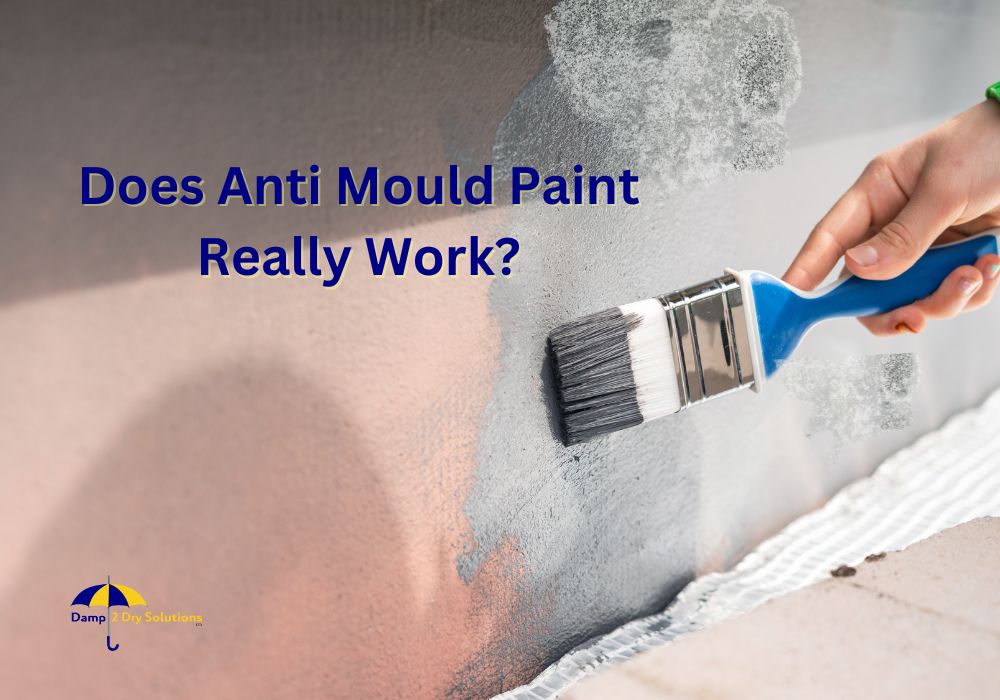
Mould is a common problem in many homes, especially in humid and damp areas, where condensation can cause mould.
It can cause health issues, such as allergies, asthma, and infections, as well as damage to the structure and appearance of the house.
One of the possible solutions to prevent mould growth is to use anti-mould paint or mould-resistant paint, which is a type of paint that contains additives that inhibit the growth of mould and mildew.
However, how effective is anti-mould paint in reality?
This essay will examine the efficacy of anti-mould paint by exploring its definition, composition, mechanisms of action, performance, and limitations.
Understanding Anti-Mould Paint
Anti-mould paint is a specially formulated paint infused with fungicides, biocides, or other chemicals designed to inhibit the growth of mould and mildew.
These additives are typically integrated into the paint film, creating a protective barrier against mould spores and moisture. This paint film improves the thermal performance of the surfaces and reduces the moisture that leads to mould.
This mould-resistant paint can be applied to a range of surfaces—walls, ceilings, floors, and furniture—to prevent or reduce mould infestations.
However, it’s important to note that painting over mould doesn’t entirely halt its growth. While it conceals visible signs, it doesn’t tackle the underlying causes like moisture, leaks, or inadequate ventilation.
Therefore, using anti-mould paint serves as a preventive measure rather than a solution. It should be complemented by proper cleaning and maintenance of affected areas.
Evaluating Effectiveness of Anti Mould Paint

The efficacy of anti-mould paint hinges on several variables, including the additives’ type and concentration, the paint film’s quality and durability, environmental conditions, and application methods.
Numerous scientific studies have examined anti-mould paint effectiveness across diverse settings, yielding varied outcomes. While some studies indicate significant reduction in mould and mildew growth on painted surfaces, others suggest minimal impact or even instances where it encourages mould growth.
Furthermore, user experiences and testimonials present inconsistencies. While some laud its effectiveness and lasting qualities, others criticise its inefficacy, potential toxicity, or gradual deterioration.
Additionally, the distinction between mould-resistant paint and regular paint in terms of mould prevention might be marginal, given that certain regular paints also contain fungicides, biocides, or moisture-resistant properties.
Factors Influencing Performance
The effectiveness of anti-mould paint can be influenced by various factors, including proper application methods, surface compatibility, environmental conditions, and long-term durability.
For optimal performance, it’s crucial to adhere to the manufacturer’s instructions when applying mould-resistant paint. This often involves surface preparation, removing existing mould, using primer, applying multiple coats, and allowing adequate drying time.
Additionally, the compatibility of anti-mould paint with the surface and environment is vital. Some formulations may not adhere well to glossy or smooth surfaces, or withstand high levels of humidity or temperature.
Moreover, the durability of anti-mould paint is essential. It should retain its effectiveness over time, maintaining its anti-mould properties without succumbing to issues like cracking, peeling, or fading.
Addressing Misconceptions Related to Anti Mould Paint

There are some common myths and misconceptions surrounding anti-mould paint, such as the following:
Anti-mould paint can kill all types of mould and mildew
This is not true, as different types of mould and mildew may have different levels of resistance to the additives in anti-mould paint. Furthermore, certain additives might solely impede the growth of mould and mildew rather than eradicate them entirely.
Anti-mould paint can last forever
Not true, as anti-mould paint can degrade over time due to exposure to sunlight, moisture, or abrasion. The average lifespan of anti-mould paint is about 5 to 10 years, depending on the quality and maintenance of the paint.
Anti-mould paint is safe and eco-friendly
This is not true, as anti-mould paint may contain toxic or harmful chemicals that can pose health risks to humans, animals, and plants.
Some of the chemicals may also leach into the environment and cause pollution or contamination. Therefore, anti-mould paint should be used with caution and care, and disposed of properly.
Is anti mould paint better than anti condensation paint?
Mould-resistant paint stops mould, anti-condensation paint stops water droplets. They are not better than each other, but different.
Both paints may not fix dampness and mould, as they do not deal with the root causes. Use both paints and keep the areas clean and dry.
Is mould resistant paint worth it?
The answer to this question may vary depending on the situation and the preference of the user.
However, based on the evidence and analysis presented in this essay, anti-mould paint may not be worth it for the following reasons:
- Anti-mould paint may not be very effective in preventing or reducing mould growth, as it depends on various factors and may have inconsistent or contradictory results.
- Anti-mould paint may not be very different from regular paint in terms of mould prevention, as some regular paints also have anti-mould properties or features.
- Anti-mould paint may not be very safe or eco-friendly, as it may contain toxic or harmful chemicals that can cause health or environmental issues.
Conclusion
does anti mould paint really work? the efficacy of anti-mould paint depends on various factors such as the severity of existing mould, proper application, and the underlying causes of moisture. While anti-mould paint can act as a preventive measure by inhibiting mould growth to some extent, it may not completely eradicate the issue if the root cause of moisture isn’t addressed. Regular maintenance, good ventilation, and tackling moisture sources remain crucial in combating mould.
Need help with Mould Problem? Experience the difference with Damp2dry solutions for mould treatment!
Our expert team tackles mould at its root cause, offering tailored solutions to eliminate existing mould and prevent its return.
Say goodbye to unsightly patches and health concerns with our comprehensive and effective mould treatment services.
Trust Damp2dry for a mould-free, healthier living environment.
